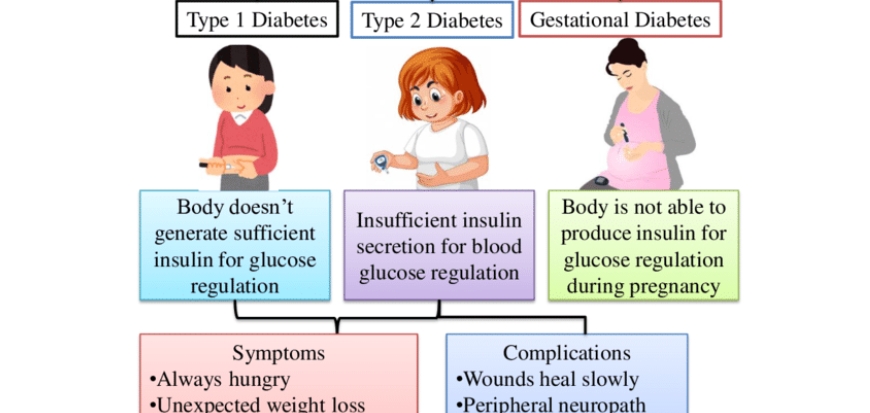Diabetes:
Diabetes is a chronic medical condition that occurs when the body is unable to properly regulate blood sugar (glucose) levels. Glucose is a vital source of energy for cells and tissues, and its levels need to be carefully controlled in the bloodstream. Insulin, a hormone produced by the pancreas, plays a crucial role in this regulation.
Types of Diabetes:

Type1Diabetes:
This is an autoimmune condition where the immune system mistakenly attacks and destroys the insulin-producing cells in the pancreas. As a result, the body produces little to no insulin. People with Type 1 diabetes need to take insulin injections or use an insulin pump to manage their blood sugar levels.
Type 2 Diabetes:
This form of diabetes is characterized by insulin resistance, where the body’s cells become less responsive to the effects of insulin. Initially, the pancreas produces extra insulin to compensate for this resistance, but over time, it may not be able to keep up. Type 2 diabetes is often associated with lifestyle factors such as obesity, lack of physical activity, and poor dietary choices. It can be managed through a combination of lifestyle changes, oral medications, and in some cases, insulin therapy.
Gestational Diabetes:
This type of diabetes occurs during pregnancy and usually resolves after childbirth. It is caused by hormonal changes that affect insulin sensitivity. Gestational diabetes requires careful monitoring and management to ensure the health of both the mother and the baby.
- Autoimmune Factors: Type 1 diabetes is an autoimmune disease in which the immune system mistakenly attacks and destroys the insulin-producing beta cells in the pancreas.
- Lifestyle Factors: Sedentary lifestyle, poor dietary habits (high in processed foods, sugary beverages, and unhealthy fats), and excess weight contribute to the development of Type 2 diabetes. Obesity is a significant risk factor for insulin resistance
- Age: Type 2 diabetes is more commonly diagnosed in adults, particularly as people age. However, due to rising childhood obesity rates, it is increasingly diagnosed in younger individuals as well.

Symptoms:
Common Symptoms of Diabetes:
- Frequent Urination (Polyuria): Excess glucose in the blood can cause the kidneys to work harder to filter and remove it, leading to increased urination.
- Increased Thirst (Polydipsia): Frequent urination can lead to dehydration, causing an increased feeling of thirst.
- Unexplained Weight Loss: In Type 1 diabetes, the body may start breaking down muscle and fat for energy because it can’t use glucose properly. This can result in unintended weight loss.
Specific Symptoms for Type 1 Diabetes:
- Sudden Onset: Type 1 diabetes often develops rapidly and is typically diagnosed in children, adolescents, and young adults.
- Ketones in Urine: Due to the body’s inability to use glucose for energy, it starts breaking down fat for fuel, leading to the production of ketones. Ketones can be detected in urine.
- Nausea and Vomiting: Elevated blood sugar levels can cause nausea and vomiting.
Specific Symptoms for Type 2 Diabetes:
- Gradual Onset: Type 2 diabetes tends to develop more slowly, and symptoms may not be as severe initially.
- Tingling or Numbness: High blood sugar levels can damage nerves over time, leading to tingling or numbness in the hands and feet (neuropathy).
- Recurrent Infections: Yeast infections, particularly in women, can be more common due to elevated blood sugar levels creating favourable environment for the growth of yeast.

Precautions:
- Healthy Eating: Follow a balanced and nutritious diet that includes a variety of fruits, vegetables, whole grains, lean proteins, and healthy fats. Limit your intake of sugary and processed foods. Pay attention to portion sizes to help manage blood sugar levels.
- Regular Physical Activity: Engage in regular physical activity as recommended by your healthcare provider. Exercise helps improve insulin sensitivity, control weight, and promote overall cardiovascular health.
- Blood Sugar Monitoring: Regularly monitor your blood sugar levels according to your healthcare provider’s recommendations.
What other health problems can people with diabetes develop?
Over time, high blood glucose can damage your heart, kidneys, feet, and eyes. If you have diabetes, you can take steps to lower your chances of developing diabetes health problems by taking steps to improve your health and learning how to manage the disease. Managing your blood glucose, blood pressure, and cholesterol levels can help prevent future health problems.
Exercises for Diabetes Management:

Aerobic Exercises:
Walking: A simple and effective way to increase physical activity. Aim for at least 30 minutes of brisk walking most days of the week.
Cycling: Whether on a stationary bike or outdoors, cycling helps improve cardiovascular fitness.
Swimming: A low-impact exercise that works various muscle groups while being gentle on joints.
Strength Training:
Resistance Bands: Using resistance bands for strength exercises can help build muscle and improve metabolism.
Free Weights: Incorporate weightlifting or body weight exercises like squats, lunges, and push-ups to strengthen muscles.

How does physiotherapy helps Diabetes Patient?
- Blood Sugar Control: Regular physical activity can help lower blood sugar levels by increasing the uptake of glucose by muscles, thereby reducing insulin resistance. Physiotherapists can design personalized exercise programs that are safe and effective for individuals with diabetes, helping to maintain stable blood sugar levels.
- Cardiovascular Health: Diabetes increases the risk of cardiovascular complications. Physiotherapy can enhance cardiovascular fitness, strengthen the heart, and improve circulation, reducing the risk of heart-related issues like heart disease, high blood pressure.
- Muscle Strength and Flexibility: Diabetes can sometimes lead to muscle weakness and stiffness. Physiotherapy exercises can help improve muscle strength, flexibility, and overall mobility, making it easier for individuals to perform daily activities and stay active.
- Joint Health: Diabetes may increase the risk of joint problems, such as osteoarthritis. Physiotherapists can design exercise programs that promote joint health, reduce pain, and maintain joint function.

How does Hydrotherapy helps Diabetes Patient?
- Low-Impact Exercise: Hydrotherapy provides a low-impact environment that reduces stress on joints and muscles. This is especially beneficial for individuals with diabetes who might have neuropathy or joint issues, as it allows them to engage in physical activity without putting excessive strain on their bodies.
- Improved Blood Circulation: The buoyancy of water can help improve blood circulation throughout the body. This is particularly important for diabetes patients, as it can aid in delivering oxygen and nutrients to tissues and promoting overall cardiovascular health.
- Enhanced Muscle Strength and Flexibility: Water resistance provides a gentle yet effective form of resistance training. Performing exercises in water helps build muscle strength and improve flexibility, which can contribute to better mobility and overall physical function.
Conclusion:
Physiotherapy and hydrotherapy offer valuable contributions to the holistic management of diabetes. These therapeutic approaches play a significant role in improving the overall health and well-being of individuals living with diabetes.
A team of Physiotherapists in Alexa Clinic under the guidance of Dr. Shipra Kumari, Chief Physiotherapist and certified Aquatic Therapist (IATF Switzerland). Alexa Clinic is a super-specialty physiotherapy and aquatic therapy clinic first of its kind opened in Kolkata in the in the year 2019. With many accolades and recognition Alexa Clinic has treated more than 10,000 patients suffering from various illnesses.
It’s easy to book an appointment with Dr. Shipra Kumari over a call or visit the 8777694040 websites of Alexa Healthcare.
https://www.facebook.com/alexaactiveaging
https://www.youtube.com/@alexaactiveaging
https://www.linkedin.com/company/alexaphysiotherapyclinic
https://www.instagram.com/alexaactiveaging/
#Physiotherapy #PhysicalTherapy #PTRehab #MovementMatters #TherapyWorks #PTforLife #PTHelp #PTStrong #Rehabilitation #PhysicalHealth #PTGoals #HealingHands #MoveBetter #StayActive #RecoveryJourney #HealthyBody #PainFreeLiving # #DiabetesAwareness #Type1Diabetes #Type2Diabetes #DiabetesCommunity #T1D #T2D #DiabetesSupport #HealthyLiving #DiabetesWarrioBloodSug

